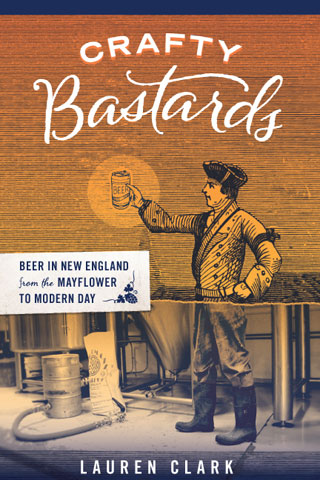Archive for the ‘Books & resources’ Category
September 16th, 2010
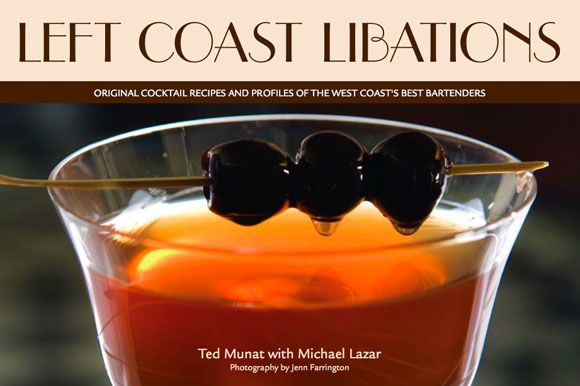
Ted Munat blogged this recently: “I love the cocktail industry. It is brimming with creativity and with beautiful and amazing people. The affection people have for what they do, and for the others that do it, is unmatched in any other community on earth I have ever encountered.”
You might view that as mushy hyperbole from a happy drunk if Ted didn’t just publish a book, Left Coast Libations, that makes a solid case for the above statement over 160 pages of bartender profiles, city descriptions and recipes/photos of the splendid mixology that’s happening on the other side of the country. Left Coast Libations is an intelligent, cheeky, utterly heartfelt love letter to “the art of West Coast bartending.”
The book grew out of a pamphlet that Ted and his brother Charles put together and introduced, as I remember it anyway, at Tales of the Cocktail in 2008. “One copy fell into the hands of Scott Bodarky, a Bay Area book publisher,” writes Ted on the LCL website, and soon thereafter work on a “real life big boy book” began in partnership with recipe guru Michael Lazar and photographer Jenn Farrington. Here’s a brief excerpt and recipe from the Portland, Oregon section’s writeup of Evan Zimmerman of Laurelhurst Market (which I highly recommend):
“Evan’s a tornado behind the bar. And creative, wild, borderline insane shit flies in every direction from where he stands. For the love of God, the man’s drink in this book calls for smoked ice. Do you have any idea how far gone from reality a person has to be to conceive of smoking ice? I was a teenager once, and I tried smoking just about everything… but never ice.”
Smoke Signals
1 1/2 oz Tennessee whiskey
1 oz manzanilla sherry
3/4 oz Pecan Syrup
1/2 lemon juice
1 dash The Bitter Truth Jerry Thomas’ Own Decanter bitters
Smoked ice
Combine all the ingredients except smoked ice in a shaker with (not smoked) ice. Shake hard. Double-strain over a 2″ by 2″ block of the smoked ice in an Old Fashioned glass.
If you want to know how to make smoked ice and pecan syrup — and you like fun cocktail writing and tasty recipes — you have to buy the book. (Don’t worry, not every recipe in LCL calls for such complicated ingredients).
I don’t know if there will ever be an East Coast Cocktails-or-something-or-other to rival LCL, but, Ted & Co., you have officially fired the first shot. Cheers and congrats to you all.
Tags: California, Left Coast Libations, Oregon, Ted Munat, Washington, West Coast
Posted in Books & resources, Cocktails | 6 Comments »
September 7th, 2010
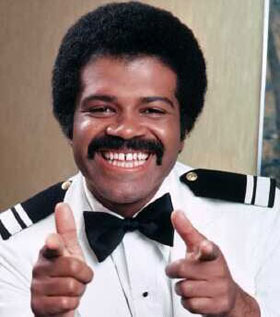 “I’m thinking of becoming a bartender. Where do I start?” is a question I get asked regularly. It generally comes from people fired up about the rise of craft mixology, the notion of bartending as a “real” career, and the infectious passion and knowledge displayed by many of today’s serious bartenders. People fed up with their day jobs, or just out of college and considering career choices, dream of hoisting a Boston shaker and making the world happy with good drinks and banter like Ted Lange on the Love Boat.
“I’m thinking of becoming a bartender. Where do I start?” is a question I get asked regularly. It generally comes from people fired up about the rise of craft mixology, the notion of bartending as a “real” career, and the infectious passion and knowledge displayed by many of today’s serious bartenders. People fed up with their day jobs, or just out of college and considering career choices, dream of hoisting a Boston shaker and making the world happy with good drinks and banter like Ted Lange on the Love Boat.
These are all fine reasons to want the job. Oh, the money can be good, too. But unless you own the bar or are very close to the person who does, you’re probably not going to find yourself behind the slab if you don’t have experience. OK, so how do you get there? Here’s some advice that comes from conversations I’ve had with career bartenders. By the way, this isn’t a step-by-step process; it’s a multi-pronged strategy.
You don’t need a license or a bartending-school diploma. There’s no such thing as a bartending license. (However, many bartenders must take the TIPS course on avoiding overserving or serving to minors.) Most bartenders don’t recommend bartending school; very few of the professionals I know have attended one. They say that while it won’t hurt your chances of getting a job, it doesn’t really prepare you for working in a real bar, and that your money and time are better spent on some of the following.
Learn all you can on your own. Get some basic bar equipment, some recommended books (Gary Regan’s Joy of Mixology and Dale DeGroff’s Craft of the Cocktail are good places to start) and some booze, watch a few videos by bar/mixology experts, and start mixing drinks at home. (Also, consider taking a short, basic mixology class at the Boston Shaker in Somerville.) This will give you a certain comfort level with pouring, measuring and shaking/stirring. Your friends and neighbors will serve as your first customers.
Take a lot of field trips. Again, this is where your bartending-school money is probably better spent — at actual bars. Go to a top-notch cocktail bar, park yourself on a stool and observe, observe, observe. Watch the bartenders’ drink-making technique, see how they multi-task and interact with guests, notice the types of spirits they use, witness them card or shut off a customer (hopefully not you).
Talk to your bartender. It should go without saying that you only do this during lulls in service. And don’t ask, “How do I do what you do?” Rather, think of specific questions like, “Why do you shake some drinks and stir others?” or “Could you tell me about the bitters you used in my drink?” or “What do you do to prep the bar for a shift?” or “How did you start tending bar?” Note: being a good-tipping regular will greatly facilitate these interactions. See: How to treat a bartender.
Get experience any way, anywhere you can. Even it it’s unpaid at first. Got an acquaintance who works for a catering company or does events where drinks are served? Offer to go along and cut limes, fetch ice, etc. Find a bar that has sleepy daytime shifts and offer to work other positions that need filling in exchange for getting a shot at a bar shift. Put feelers out to all those bartenders you’ve been getting to know as a customer. See if a bar is willing to try you out for a couple of uncompensated bar-back shifts.
Be realistic. The bartenders who are truly adept at what they do have usually been at it for several years. They have the personalities, talent and toughness it takes to stick with a job that demands long hours without a break, is physically and psychically stressful, generally offers no benefits of any kind, and involves the various hazards of late-night shenanigans. You will probably know very quickly whether you are cut out for this. That said, I don’t mean to discourage you. Give it a try. A good bartender is always in demand.
Tags: bartender training, bartending career, bartending school
Posted in Bartenders, Books & resources | 4 Comments »
August 27th, 2010
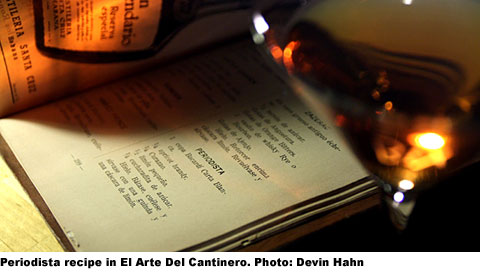
Watch out when making off-hand remarks around Devin Hahn, author of the blog Periodista Tales. He will record everything you say. Then publish it. The thing is, you’ll be (mostly) thankful he did.
Hahn began writing the engaging, real-time narrative of his quest to find the origins of the Periodista — a drink found on multiple cocktail menus in Boston but apparently unknown in other cities — a mere few months ago. And already, the description of the Periodista on the menu at Eastern Standard pays homage to him. Already, cocktail historians around the country know about him.
In his most recent installment, he describes a sit-down we had at the Franklin Cafe to talk about this apparently Cuban cocktail (of which he now knows more than probably anyone alive) and other matters of the Boston drink scene.
If you dig cocktail history and haven’t checked out Hahn’s blog yet, I suggest you start from the beginning.
Tags: Cuba, Devin Hahn, Periodista
Posted in Books & resources, Cocktails, drinkboston in the news, Rum | No Comments »
July 13th, 2010
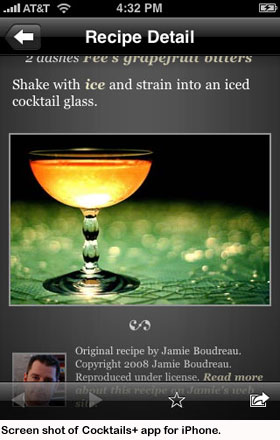 When it comes to iPhone apps, I’m a minimalist. Until a friend suggested recently that I write about cocktail apps, I only had one on my phone: Cocktails+. It was developed in part by Ted Haigh and Martin Doudoroff, the team behind the cocktail website I frequent most: the Internet Cocktail Database, or CocktailDB.com. I like the Cocktails+ app. It’s heavy on historic drinks, it includes the source(s) for each recipe, and it’s attractive and easy to read. Honestly, though, I have only used it a handful of times. That’s because my actual favorite cocktail app is a talented bartender. I mean, who needs to consult a mobile device when you have a person in front of you who can help you choose a great drink and tell you the story behind it?
When it comes to iPhone apps, I’m a minimalist. Until a friend suggested recently that I write about cocktail apps, I only had one on my phone: Cocktails+. It was developed in part by Ted Haigh and Martin Doudoroff, the team behind the cocktail website I frequent most: the Internet Cocktail Database, or CocktailDB.com. I like the Cocktails+ app. It’s heavy on historic drinks, it includes the source(s) for each recipe, and it’s attractive and easy to read. Honestly, though, I have only used it a handful of times. That’s because my actual favorite cocktail app is a talented bartender. I mean, who needs to consult a mobile device when you have a person in front of you who can help you choose a great drink and tell you the story behind it?
Oh right. We’re not always in bars with talented bartenders, and we’re not always in bars, period. And we don’t carry our cocktail-book libraries around with us. So I figured I’d do a little research for the team to see which cocktail apps are worthwhile for us discerning drinkers. It took me about five minutes to figure out that most of the stuff listed in the iTunes app store was unworthy (to put it kindly), unless drinkboston readers secretly yearn to possess 7,000 recipes for flavored-vodka shooters. It took me about another 30 minutes on the Google, the Facebook and the Twitter to tease out which apps the drinkerati have approved. Here are the fruits of my hard labor.
Cocktails+ $2.99. “The authoritative cocktail reference for the iPhone.” The 2,000+ recipes include mostly classics, but there are many contemporary recipes by Jamie Boudreau, Dale DeGroff and Goncalo Monteiro. Cool feature: share recipes not only via email (which most of these apps do) but also Facebook and Twitter.
Flip n’ Drink $3.99. Authors Gary and Mardee Regan, the folks behind Ardent Spirits, selected and tested the hundreds of recipes on this attractive app, and they are continually adding more from an impressive list of contributors. Cool features: cocktail recommendations based on your current selection, and “cocktail conversations” — fun facts related to each recipe. Beware: the app’s over 20MB, so I got a message saying I had to download it via a computer rather than wirelessly.
Cocktails Made Easy $2.99. Based on a solid concept: 500 recipes that you can make with just 14 different spirits (plus mixers). The recipes are from diffordsguide.com by British drinks industry guru Simon Difford. Cool feature: click on the bottles of liquor you currently have in your inventory, and get a list of the drinks you can make.
101 Cocktails $1.99. “Do I really need 14,000 cocktail recipes?” asks L.A. blogger Jimmy Patrick (Jimmy’s Cocktail Hour), who developed this blessedly streamlined app. For those times when you just want the basics, this is perfect.
Tiki+ $3.99. More than 150 authentic tiki recipes culled from Beachbum Berry’s books. Illustrated with vintage drink photos and art, the app lets you share recipes via Facebook and Twitter. NOTE: Tiki+ is currently being upgraded for iPad compatibility, but it will be back on sale soon.
Please comment if there’s a great cocktail app out there that I missed — and also if you have a go-to beer or wine app. Meanwhile, I need an app with real-time info on the best bars and up-to-date schedules of my favorite bartenders.
Tags: app, iphone
Posted in Books & resources, Cocktails | 11 Comments »
April 25th, 2010

By Scott N. Howe
It was, of course, a stupid idea.
The 18th Amendment to the Constitution, which prohibited the “manufacture, sale, or transportation of intoxicating liquors” in the U.S., expanded government involvement in the lives of citizens and turned millions of regular folks who just wanted a beer into criminals. The amendment, and the Volstead Act that enforced it, also led to an explosion in organized crime, encouraged legitimate businesses to circumvent the law, and subjected the United States to the ridicule of many throughout the world. Winston Churchill called Prohibition “an affront to the whole history of mankind.”
Today, it seems amazing that it happened at all, but Daniel Okrent’s new book, Last Call: The Rise and Fall of Prohibition, makes as much sense of the era as can be made. The book illuminates the social and political factors that led to Prohibition’s passage in 1919. The women’s suffrage movement, mixed with anti-immigrant sentiment and shaken vigorously with righteous, saloon-hating religious elements, created a potent cocktail that intoxicated just enough congressmen and state legislators to enshrine the 18th Amendment into the Constitution.
Last Call humanizes Prohibition, discussing many individuals who made their names on both the “wet” and “dry” sides of the issue — people like Al Capone, Billy Sunday, H.L. Mencken, William Jennings Bryan, Carrie Nation, Susan B. Anthony, and Sam Bronfman – the Canadian bootlegger who went on to run the Seagram’s empire. Okrent also re-introduces several long-forgotten figures who played important roles during the era, including the Anti-Saloon League’s Wayne Wheeler, a political operative Okrent compares to Karl Rove, and Assistant Attorney General Mabel Willebrandt, arguably the most famous and powerful woman in America during the 1920s.
Drinkboston readers will find plenty of local angles in Last Call. For example, the book examines the work of Dorchester’s Mary Hanchett Hunt, who brought temperance education to millions of American school kids in the late 1800s and even established a “Scientific Temperance Museum” at her home on Trull Street. You’ll also find a detailed look at how bootleggers along the East Coast’s “Rum Row” brought booze to New England during the ‘20s, as well as a convincing argument that Joseph P. Kennedy was not, in fact, a bootlegger.
Those looking for a rollicking ride through the Roaring ’20s, however, may be disappointed in Last Call. Yes, you’ll find flirty flappers, charmingly corrupt politicians, saucy speakeasies, F. Scott Fitzgerald, and even Elliott Ness’s “Untouchables.” Mostly, however, you’ll find a sober (sorry) look at a twisted time in American history. So sober, in fact, that Okrent includes the entire text of the U.S. Constitution in the book’s appendix. That’s because Last Call isn’t about what happens when you take a drink, it’s about what happens when the law takes that drink away.
Tags: Daniel Okrent, history, Prohibition, Scott N. Howe
Posted in Books & resources | No Comments »



 When it comes to iPhone apps, I’m a minimalist. Until a friend suggested recently that I write about cocktail apps, I only had one on my phone:
When it comes to iPhone apps, I’m a minimalist. Until a friend suggested recently that I write about cocktail apps, I only had one on my phone: 
